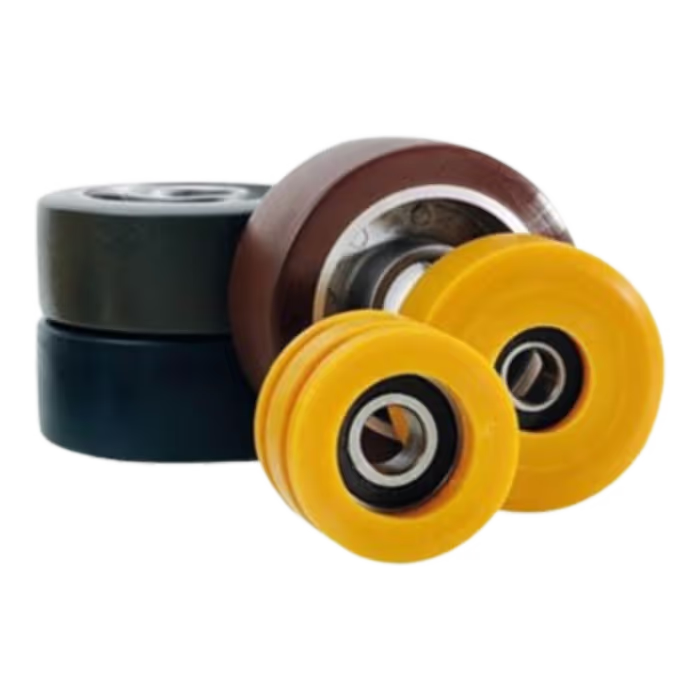
Durability: Highly resistant to wear, abrasion, and tearing, making PU components ideal for high-friction and heavy-duty applications

Flexibility: Available in a wide range of hardness levels (Shore A to Shore D), offering both flexible and rigid solutions

Chemical Resistance: Resistant to oils, greases, solvents, and many chemicals, making them suitable for industrial and automotive applications

Load-Bearing: PU components can bear significant weight without permanent deformation, which is ideal for heavy-duty machinery

Impact Resistance: Excellent shock absorption and impact resistance, making them useful in applications subject to sudden forces or vibrations

Weather and UV Resistance: UV-stabilized PU components are resistant to sunlight and environmental weathering, ideal for outdoor applications

Temperature Range: Able to perform in temperatures ranging from -40°C to 80°C, with certain formulations capable of tolerating higher temperatures

Water Resistance: Does not absorb water, making it suitable for submerged or water-exposed environments

Customization: Can be manufactured in various shapes, sizes, and hardness levels to meet specific application needs

Suspension Bushings: Used to reduce friction and absorb vibrations

Seals and Gaskets: Prevent leakage of fluids and gases

Wheels and Rollers: Used in conveyor systems and heavy machinery

Bearings and Bushings: Used for reducing friction in moving parts

Wear Pads and Liners: Protect machinery and surfaces from abrasion

Rollers: Used for material handling, providing smooth movement

Guides: Ensure alignment and smooth operation of conveyor belts

Wear-resistant Liners: Protect equipment from abrasion when handling rocks, ores, and heavy materials

Scrapers and Seals: Used in mining machinery to improve performance and reduce wear

Formwork Liners: Used in concrete molds to prevent damage to molds and improve the quality of castings

Protective Pads: Used on construction equipment to reduce damage from impacts

Harvesting Blades: High-wear-resistant blades for cutting and harvesting crops

Wear Strips and Pads: Protect farm equipment from abrasion

Compliant Seals: Ensure hygiene and prevent contamination in food processing machines

Conveyor Rollers: Used in food production and packaging lines

Dock Fenders: Protect boats and docks from damage due to impacts

Boat Bumpers: Provide shock absorption for boats when docking

Wheels: Used in skateboards, inline skates, and other sports equipment

Protective Gear: PU components are used in items like knee pads, elbow pads, and helmets

Enhanced Durability: PU components have a longer life span than many other materials, especially under heavy wear or abrasive conditions

Customizable Hardness: PU can be formulated with varying degrees of flexibility and hardness, tailored to meet specific needs

Chemical and Environmental Resistance: Resistant to oils, solvents, UV rays, and various chemicals, making it ideal for harsh environments

Cost-Effective: Although PU may have a higher initial cost than some materials, its durability and long life make it cost-effective in the long run

Improved Performance: PU components perform better in terms of noise reduction, shock absorption, and vibration control compared to many alternatives

Non-Toxic and Safe: Many PU components are FDA-approved and safe for food, medical, and water applications

Shape and Size: PU components can be made to a variety of shapes, sizes, and configurations to suit specific industrial needs

Hardness: From soft, rubber-like formulations to rigid, tough varieties, PU components can be customized based on the hardness required for the application

Color: Available in standard and custom colors for ease of identification or aesthetic purposes

UV Stabilizers: To prevent degradation from exposure to sunlight

Anti-Static: For use in sensitive electronic environments

Flame Retardants: To reduce the risk of fire in high-risk areas

Cutting: PU components can be cut to size using saws, lasers, or other cutting tools

Molding: Custom molds can be used to create complex shapes for specific applications

Drilling and Machining: PU can be drilled, milled, or turned into custom parts with standard machining tools

Joining: Bonding PU components requires specific adhesives or welding techniques for certain applications












































